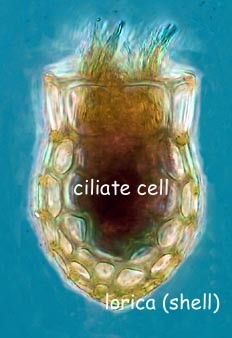- Tintinnid
Taxobox | color = khaki
name = Tintinnids

image_width = 200px
domain = Eukaryota
unranked_phylum =Alveolata
phylum = Ciliophora
classis =Spirotrich ea
subclassis =Choreotrich ia
ordo = Tintinnida
ordo_authority = Kofoid & Campbell, 1929Tintinnids are
ciliates of the choreotrichtaxon "Tintinnida", distinguished by vase-shaped shells calledlorica e, which are mostly protein but may incorporate minute pieces of minerals. Although appearing as early as theOrdovician period, tintinnids became abundant in the fossil record during theJurassic . Tintinnids are an important part of the fossil record because of the rarity with which most other ciliates become preserved under the conditions of the marine environment. The loricae of some tintinnids are easily preserved, giving them a relatively good fossil record.Like other protists, tintinnids are single-celled organisms. Tintinnids are heterotrophic aquatic organisms. They feed primarily on photosynthetic
algae andbacteria . They are part of the microzooplankton (between 20 and 200micrometre s in size). Tintinnids are found in marine and freshwaters. However, they are most common in salt water and are usually present in concentrations of about 100 a liter but can reach abundances of several thousand perlitre . Characteristics of their lorica, or shells, are used to distinguish between the roughly 500 species described.Many species appear to have wide distributions (for example from the
Chesapeake Bay toNew Caledonia ) while others are restricted to certain areas, such as arctic waters or coastal seas. Nonetheless, in any given locale dozens of species can be found. Like other members of the microzooplankton (such asoligotrich ciliates, heterotrophicdinoflagellate s,radiolarian s, etc.), tintinnids are a vital link in aquatic food chains as they are the 'herbivore s' of the plankton. They feed onphytoplankton (algae and cyanobacteria) and in turn act as food for larger organisms such ascopepod s (smallcrustacean s) and larval fish.The image is a specimen of Dictyocysta mitra from the Bay of Villefranche in the Mediterranean Sea. The hair-like projections pointing out of the top of the shell are the cilia of the cell. The cilia generate a water flow across the mouth of the cell, bringing food into contact and move the tintinnid. Their swimming pattern is rather 'jumpy'- or dancing- they are part of the 'choreotrichs' which means dancing hairs from their swimming behaviour and cilia.
Wikimedia Foundation. 2010.
